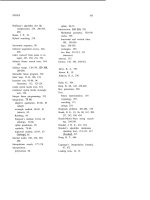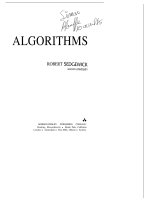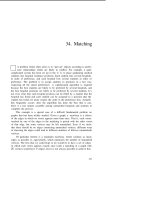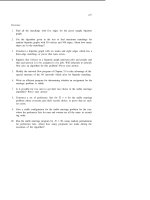Tài liệu Thuật toán Algorithms (Phần 32) pdf
Bạn đang xem bản rút gọn của tài liệu. Xem và tải ngay bản đầy đủ của tài liệu tại đây (133.89 KB, 10 trang )
303
Exercises
1.
2.
3.
4.
5.
6.
7.
8.
9.
10.
Decrypt the following message, which was encrypted with a Vigenere
cipher using the pattern CAB (repeated as necessary) for the key (on a
27-letter alphabet, with blank preceding A): DOBHBUAASXFZWJQQ
What table should be used to decrypt messages that have been encrypted
using the table substitution method?
Suppose that a Vigenere cipher with a two-character key is used to encrypt
a relatively long message. Write a program to infer the key, based on the
assumption that the frequency of occurrence of each character in odd
positions should be roughly equal to the frequency of occurrence of each
character in the even positions.
Write matching encryption and decryption procedures which use the
“exclusive or” operation between a binary version of the message with
a binary stream from one of the linear congruential random number
generators of Chapter 3.
Write a program to “break” the method given in the previous exercise,
assuming that the first 10 characters of the message are known to be
blanks.
Could one encrypt plaintext by “and”ing it (bit by bit) with the key?
Explain why or why not.
True or false: Public-key cryptography makes it convenient to send the
same message to several different users. Discuss your answer.
What is P(S(M)) for the RSA method for public-key cryptography?
RSA encoding might involve computing Mn, where M might be a k digit
number, represented in an array of k integers, say. About how many
operations would be required for this computation?
Implement encryption/decryption procedures for the RSA method (as-
sume that s, p and N are all given and represented in arrays of integers
of size 25).
304
SOURCES for String Processing
The best references for further information on many of the algorithms in
this section are the original sources. Knuth, Morris, and Pratt’s 1977 paper
and Boyer and Moore’s 1977 paper form the basis for much of the material
from Chapter 19. The 1968 paper by Thompson is the basis for the regular-
expression pattern matcher of Chapters 20-21. Huffman’s 1952 paper, though
it predates many of the algorithmic considerations here, still makes interesting
reading. Rivest, Shamir, and Adleman describe fully the implementation and
applications of their public-key cryptosystem in their 1978 paper.
The book by Standish is a good general reference for many of the topics
covered in these chapters, especially Chapters 19, 22, and 23. Parsing and
compiling are viewed by many to be the heart of computer science, and there
are a large number of standard references available, for example the book
by
Aho
and Ullman. An extensive amount of background information on
cryptography may be found in the book by Kahn.
A. V.
Aho
and J. D. Ullman, Principles of Compiler Design, Addison-Wesley,
Reading, MA, 1977.
R. S. Boyer and J. S. Moore, “A fast string searching algorithm,” Communica-
tions of the ACM, 20, 10 (October, 1977).
D. A. Huffman, “A method for the construction of minimum-redundancy
codes,”
Proceedings
of the IRE,
40
(1952).
D. Kahn, The Codebreakers, Macmillan, New York, 1967.
D. E. Knuth, J. H. Morris, and V. R. Pratt, “Fast pattern matching in strings,”
SIAM Journal on Computing, 6, 2 (June, 1977).
R. L. Rivest, A. Shamir and L. Adleman,
“A method for obtaining digital
signatures and public-key cryptosystems,” Communications of the ACM, 21,
2 (February, 1978).
T. A. Standish, Data Structure Techniques, Addison-Wesley, Reading, MA,
1980.
K. Thompson, “Regular expression search algorithm,” Communications of the
ACM,
11,
6 (June, 1968).
GEOMETRIC ALGORITHMS
Computers are being used more and more to solve large-scale problems
which are inherently geometric. Geometric objects such as points, lines
and polygons are the basis of a broad variety of important applications and
give rise to an interesting set of problems and algorithms.
Geometric algorithms are important in design and analysis systems for
physical objects ranging from buildings and automobiles to very large-scale
integrated circuits. A designer working with a physical object has a geometric
intuition which is difficult to support in a computer representation. Many
other applications directly involve processing geometric data. For example,
a political “gerrymandering” scheme to divide a district up into areas which
have equal population (and which satisfy other criteria such as putting most
of the members of the other party in one area) is a sophisticated geometric
algorithm. Other applications abound in mathematics and statistics, where
many types of problems arise which can be naturally set in a geometric
representation.
Most of the algorithms that we’ve studied have involved text and num-
bers, which are represented and processed naturally in most programming
environments. Indeed, the primitive operations required are implemented in
the hardware of most computer systems. For geometric problems, we’ll see
that the situation is different: even the most elementary operations on points
and lines can be computationally challenging.
Geometric problems are easy to visualize, but that can be a liability.
Many problems which can be solved instantly by a person looking at a piece
of paper (example: is a given point inside a given polygon?) require non-
trivial computer programs. For more complicated problems, as in many other
applications, the method of solution appropriate for implementation on a
computer might be quite different from the method of solution appropriate
for a person.
307
CWAPTER 24
One might suspect that geometric algorithms would have a long history
because of the constructive nature of ancient geometry and because useful
applications are so widespread, but actually much of the work in the field
has been quite recent. Of course, it is often the case that the work of an-
cient mathematicians has useful application in the development of algorithms
for modern computers. The field of geometric algorithms is interesting to
study because there is strong historical context, because new fundamental
algorithms are still being developed, and because many important large-scale
applications require these algorithms.
Points, Lines, and Polygons
Most of the programs that we’ll study will operate on simple geometric objects
defined in a two-dimensional space. (But we will consider a few algorithms
which work in higher dimensions.) The fundamental object is a point, which
we’ll consider to be a pair of integers -the “coordinates” of the point in
the usual Cartesian system. Considering only points with integer coordinates
leads to slightly simpler and more efficient algorithms, and is not as severe a
restriction as it might seem. A line is a pair of points, which we assume are
connected together by a straight line segment. A polygon is a list of points: we
assume that successive points are connected by lines and that the first point
is connected to the last to make a closed figure.
To work with these geometric objects, we need to be decide how to
represent them. Most of our programs will use the obvious representations
type point = record
x,y:
integer end;
line = record pl, p2: point end;
Note that points are restricted to have integer coordinates. A real repre-
sentation could also be used. However, it is important to note that restricting
the algorithms to process only integers can be a very significant timesaver
in many computing environments, because integer calculations are typically
much more efficient that “floating-point” calculations. Thus, when we can get
by with dealing only with integers without introducing much extra complica-
tion, we will do so.
More complicated geometric objects will be represented in terms of these
basic components. For example, polygons will be represented as arrays of
points. Note that using arrays of lines would result in each point on the
polygon being included twice (though that still might be the natural repre-
sentation for some algorithms). Also, it is useful for some applications to
include extra information associated with each point or line. This can clearly
be handled by adding an info field to the records.
ELEMENTARY GEOMETRIC METHODS
309
We’ll use the following set of sixteen points to illustrate the operation of
several geometric algorithms:
.E
l K
‘0
l F
*A
‘C
‘I
‘G
‘N
‘L
l
J
‘H
l D
l M
l B
The points are labeled with single letters for reference in explaining the
examples. The programs usually have no reason to refer to points by “name”;
they are simply stored in an array and are referred to by index. Of course,
the order in which the points appear in the array may be important in some
of the programs: indeed, it is the goal of some geometric algorithms to “sort”
the points into some particular order.
The labels that we use are assigned
in the order in which the points are assumed to appear in the input. These
points have the following integer coordinates:
ABCDEFGH I JKLMNOP
x:
3 11
6 4 5 8
1
7 9 14 10 16 15 13 2 12
y:
9
1
8 3 15 11 6 4 7 5 13 14 2
16
12 10
A typical program will maintain an array p [1 N] of points and simply
read in N pairs of integers, assigning the first pair to the x and y coordinates
of p [I], the second pair to the x and y coordinates of p
[2],
etc. When p
is representing a polygon, it is sometimes convenient to maintain “sentinel”
values p[O]=p[N] and
p[N+l]=p[l].
310
CXAPTER 24
At some’ point, we usually want to “draw” our geometric objects. Even
if this is not inherent in the application, it is certainly more pleasant to work
with pictures than numbers when developing or debugging a new implemen-
tation. It is clear that the fundamental operation here is drawing a line. Many
types of hardware devices have this capability, but it is reasonable to consider
drawing lines using just characters, so that we can print approximations to
picture of our objects directly as output to Pascal programs (for example).
Our restriction to integer point coordinates helps us here: given a line, we
simply want a collection of points that approximates the line. The following
recursive program draws a line by drawing the endpoints, then splitting the
line in half and drawing the two halves.
procedure draw(l: line) ;
var dx, dy: integer;
t:
point;
11,12:
line;
begin
dot(l.pl.x,l.pl.y);
dot(l.p2.x,l.p2.y);
dx:=J.p2.x-1.pl.x;
dy:=l.p2.y-1.pl.y;
if
(abs(dx)>l)
or (abs(dy)>l) then
begin
t.x:=l.pl
.x+dx div 2; t.y:=l.pl .y+dy div 2;
Il.pl:=l.pl;
H.p2:=t; draw(l1);
/2.pl:=t;
/2.p2:=l.p2; draw(12);
end ;
end ;
The procedure dot is assumed to “draw” a single point. One way to
implement this is to maintain a two-dimensional array of characters with one
character per point allowed, initialized to
“a”.
The dot simply corresponds to
storing a different character (say
rr*“)
in the array position corresponding to
the referenced point. The picture is “drawn” by printing out the whole array.
For example, when the above procedure is used with such a dot procedure
with a
33x33
picture array to “draw” the lines connecting our sample points
BG, CD, EO, IL, and PK at a resolution of two characters per unit of measure,
we get the following picture:
ELEMENTARY GEOMETRIC METHODS
311
*
*
*
*
* *.
* * *
* * *
* * *
* *
* *
*.*
*
*
*
*
* *
* *
* *
*
** *
.*** *
**.*
*
***
* **
* ***
**
*
**
*
Algorithms for converting geometric objects to points in this manner are called
scan-conversion algorithms. This example illustrates that it is easy to draw
nice-looking diagonal lines like EO and IL, but that it is somewhat harder to
make lines of arbitrary slope look nice using a coarse matrix of characters. The
recursive method given above has the disadvantages that it is not particularly
efficient (some points get plotted several times) and that it doesn’t draw
certain lines very well (for example lines which are nearly horizontal and
nearly vertical). It has the advantages that it is relatively simple and that
it handles all the cases of the various orientation of the endpoints of the line
in a uniform way. Many sophisticated scan-conversion algorithms have been
developed which are more efficient and more accurate than this recursive one.
If the array has a very large number of dots, then the ragged edges of
the lines aren’t discernible, but the same types of algorithms are appropriate.
However, the very high resolution necessary to make high-quality lines can
require very large amounts of memory (or computer time), so sophisticated
algorithms are called for, or other technologies might be appropriate. For
example, the text of this book was printed on a device capable of printing
millions of dots per square inch, but most of the lines in the figures were drawn
312
CHAPTER 24
with pen and ink.
Line Intersection
As our first example of an elementary geometric problem, we’ll consider the
problem of determining whether or not two given line segments intersect. The
following diagram illustrates some of the situations that can arise.
/
E
0
When line segments actually intersect, as do CD and BG, the situation is quite
straightforward except that the endpoint of one line might fall on the other, as
in the case of KP and IL. When they don’t intersect, then we extend the line
segments and consider the position of the intersection point of these extended
lines. This point could fall on one of the segments, as in the case of IL and
BG, or it could lie on neither of the segments, as in the case of CD and OE, or
the lines could be parallel, as in the case of OE and IL. The straightforward
way to solve this problem is to find the intersection point of the lines defined
by the line segments, then check whether this intersection point falls between
the endpoints of both of the segments. Another easy method uses a tool that
we’ll find useful later, so we’ll consider it in more detail: Given a line and
oints, we’re often interested in whether the two points fall on the same
the line or not. This function is straightforward to compute from the
for the lines as follows:









